2006 DODGE RAM SRT-10 engine
[x] Cancel search: enginePage 5166 of 5267
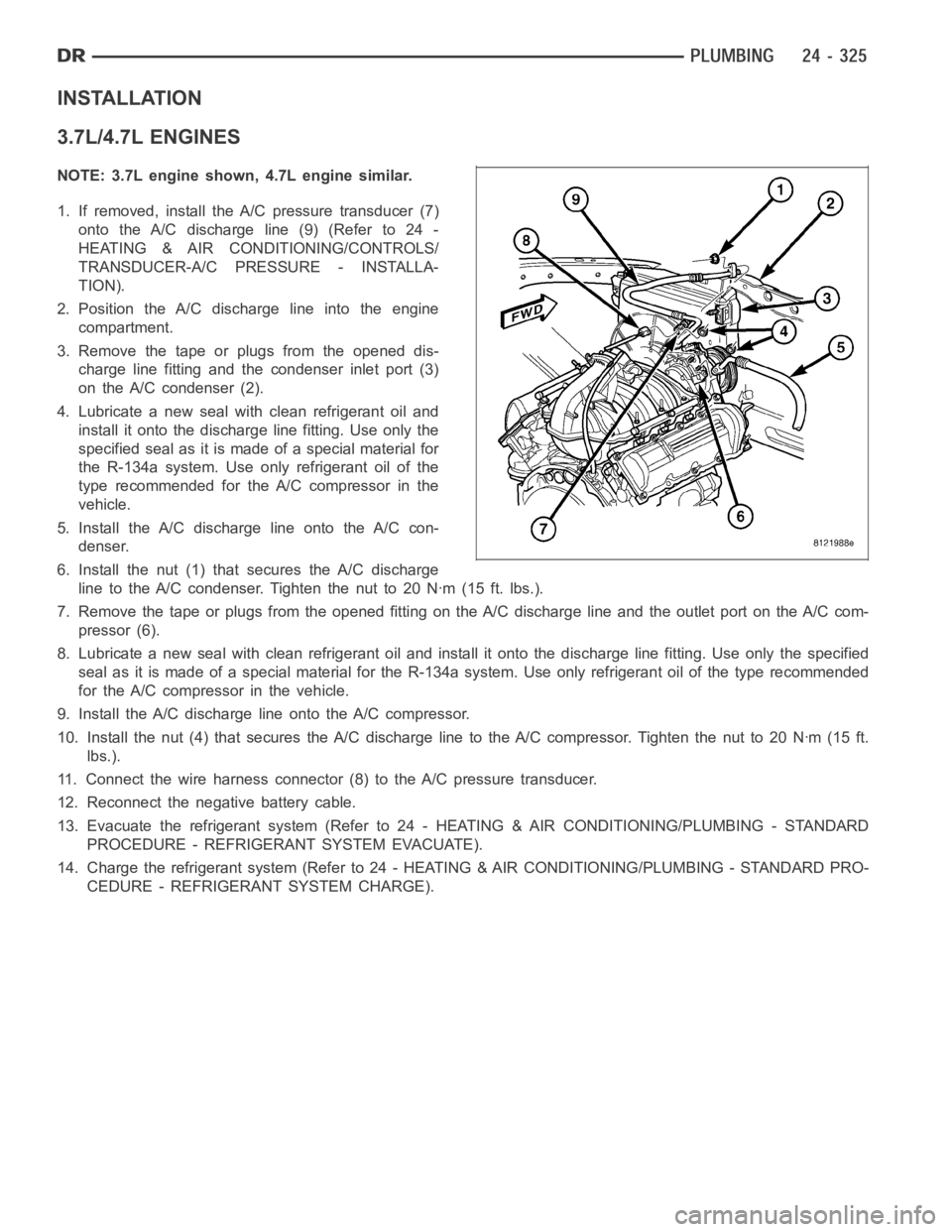
INSTALLATION
3.7L/4.7L ENGINES
NOTE: 3.7L engine shown, 4.7L engine similar.
1. If removed, install the A/C pressure transducer (7)
onto the A/C discharge line (9) (Refer to 24 -
HEATING & AIR CONDITIONING/CONTROLS/
TRANSDUCER-A/C PRESSURE - INSTALLA-
TION).
2. Position the A/C discharge line into the engine
compartment.
3. Remove the tape or plugs from the opened dis-
charge line fitting and the condenser inlet port (3)
on the A/C condenser (2).
4. Lubricate a new seal with clean refrigerant oil and
install it onto the discharge line fitting. Use only the
specified seal as it is made of a special material for
the R-134a system. Use only refrigerant oil of the
type recommended for the A/C compressor in the
vehicle.
5. Install the A/C discharge line onto the A/C con-
denser.
6. Install the nut (1) that secures the A/C discharge
line to the A/C condenser. Tighten the nut to 20 Nꞏm (15 ft. lbs.).
7. Remove the tape or plugs from the opened fitting on the A/C discharge lineand the outlet port on the A/C com-
pressor (6).
8. Lubricate a new seal with clean refrigerant oil and install it onto the discharge line fitting. Use only the specified
seal as it is made of a special material for the R-134a system. Use only refrigerant oil of the type recommended
for the A/C compressor in the vehicle.
9. Install the A/C discharge line onto the A/C compressor.
10. Install the nut (4) that secures the A/C discharge line to the A/C compressor.Tightenthenutto20Nꞏm(15ft.
lbs.).
11. Connect the wire harness connector (8) to the A/C pressure transducer.
12. Reconnect the negative battery cable.
13. Evacuate the refrigerant system (Refer to 24 - HEATING & AIR CONDITIONING/PLUMBING - STANDARD
PROCEDURE - REFRIGERANT SYSTEM EVACUATE).
14. Charge the refrigerant system (Refer to 24 - HEATING & AIR CONDITIONING/PLUMBING - STANDARD PRO-
CEDURE - REFRIGERANT SYSTEM CHARGE).
Page 5167 of 5267
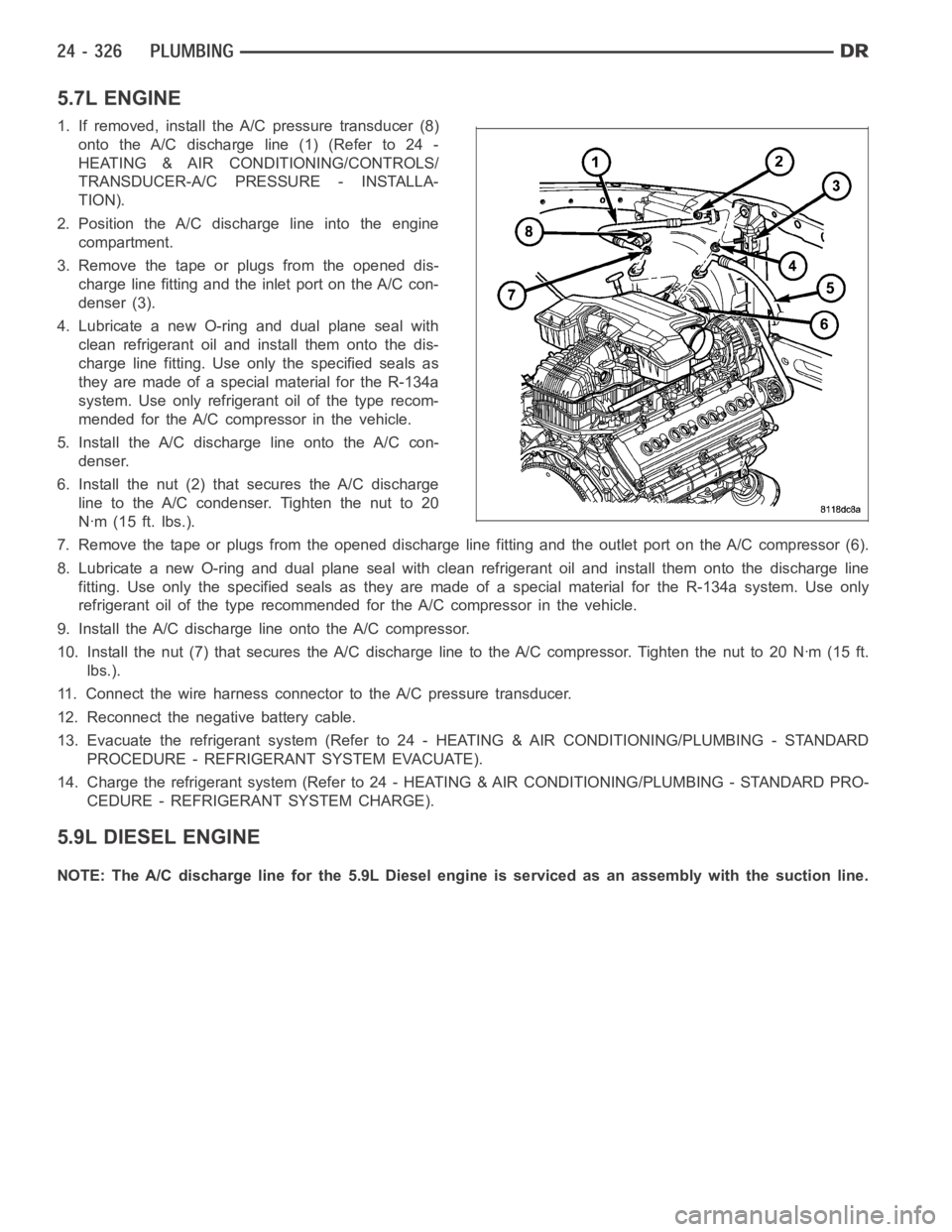
5.7L ENGINE
1. If removed, install the A/C pressure transducer (8)
onto the A/C discharge line (1) (Refer to 24 -
HEATING & AIR CONDITIONING/CONTROLS/
TRANSDUCER-A/C PRESSURE - INSTALLA-
TION).
2. Position the A/C discharge line into the engine
compartment.
3. Remove the tape or plugs from the opened dis-
charge line fitting and the inlet port on the A/C con-
denser (3).
4. Lubricate a new O-ring and dual plane seal with
clean refrigerant oil and install them onto the dis-
charge line fitting. Use only the specified seals as
they are made of a special material for the R-134a
system. Use only refrigerant oil of the type recom-
mended for the A/C compressor in the vehicle.
5. Install the A/C discharge line onto the A/C con-
denser.
6. Install the nut (2) that secures the A/C discharge
line to the A/C condenser. Tighten the nut to 20
Nꞏm (15 ft. lbs.).
7. Remove the tape or plugs from the opened discharge line fitting and the outlet port on the A/C compressor (6).
8. Lubricate a new O-ring and dual plane seal with clean refrigerant oil andinstall them onto the discharge line
fitting. Use only the specified seals as they are made of a special materialfor the R-134a system. Use only
refrigerant oil of the type recommended for the A/C compressor in the vehicle.
9. Install the A/C discharge line onto the A/C compressor.
10. Install the nut (7) that secures the A/C discharge line to the A/C compressor.Tightenthenutto20Nꞏm(15ft.
lbs.).
11. Connect the wire harness connector to the A/C pressure transducer.
12. Reconnect the negative battery cable.
13. Evacuate the refrigerant system (Refer to 24 - HEATING & AIR CONDITIONING/PLUMBING - STANDARD
PROCEDURE - REFRIGERANT SYSTEM EVACUATE).
14. Charge the refrigerant system (Refer to 24 - HEATING & AIR CONDITIONING/PLUMBING - STANDARD PRO-
CEDURE - REFRIGERANT SYSTEM CHARGE).
5.9L DIESEL ENGINE
NOTE: The A/C discharge line for the 5.9L Diesel engine is serviced as an assembly with the suction line.
Page 5168 of 5267
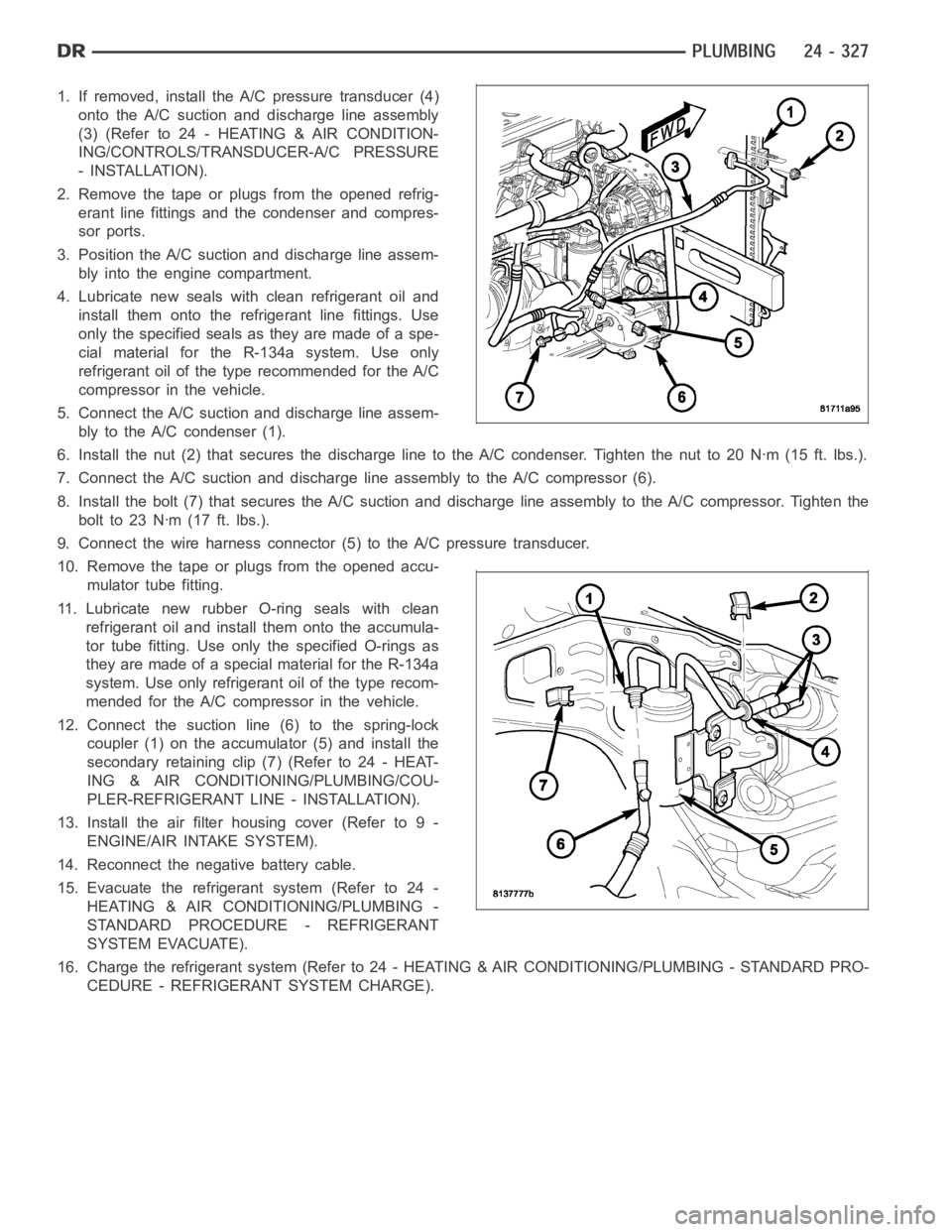
1. If removed, install the A/C pressure transducer (4)
onto the A/C suction and discharge line assembly
(3)(Referto24-HEATING&AIRCONDITION-
ING/CONTROLS/TRANSDUCER-A/C PRESSURE
- INSTALLATION).
2. Remove the tape or plugs from the opened refrig-
erant line fittings and the condenser and compres-
sor ports.
3. Position the A/C suction and discharge line assem-
bly into the engine compartment.
4. Lubricate new seals with clean refrigerant oil and
install them onto the refrigerant line fittings. Use
only the specified seals as they are made of a spe-
cial material for the R-134a system. Use only
refrigerant oil of the type recommended for the A/C
compressor in the vehicle.
5. Connect the A/C suction and discharge line assem-
bly to the A/C condenser (1).
6. Install the nut (2) that secures the discharge line to the A/C condenser.Tighten the nut to 20 Nꞏm (15 ft. lbs.).
7. Connect the A/C suction and discharge line assembly to the A/C compressor(6).
8. Install the bolt (7) that secures the A/C suction and discharge line assembly to the A/C compressor. Tighten the
boltto23Nꞏm(17ft.lbs.).
9. Connect the wire harness connector (5) to the A/C pressure transducer.
10. Remove the tape or plugs from the opened accu-
mulator tube fitting.
11. Lubricate new rubber O-ring seals with clean
refrigerant oil and install them onto the accumula-
tor tube fitting. Use only the specified O-rings as
they are made of a special material for the R-134a
system. Use only refrigerant oil of the type recom-
mended for the A/C compressor in the vehicle.
12. Connect the suction line (6) to the spring-lock
coupler (1) on the accumulator (5) and install the
secondary retaining clip (7) (Refer to 24 - HEAT-
ING & AIR CONDITIONING/PLUMBING/COU-
PLER-REFRIGERANT LINE - INSTALLATION).
13. Install the air filter housing cover (Refer to 9 -
ENGINE/AIR INTAKE SYSTEM).
14. Reconnect the negative battery cable.
15. Evacuate the refrigerant system (Refer to 24 -
HEATING & AIR CONDITIONING/PLUMBING -
STANDARD PROCEDURE - REFRIGERANT
SYSTEM EVACUATE).
16. Charge the refrigerant system (Refer to 24 - HEATING & AIR CONDITIONING/PLUMBING - STANDARD PRO-
CEDURE - REFRIGERANT SYSTEM CHARGE).
Page 5169 of 5267
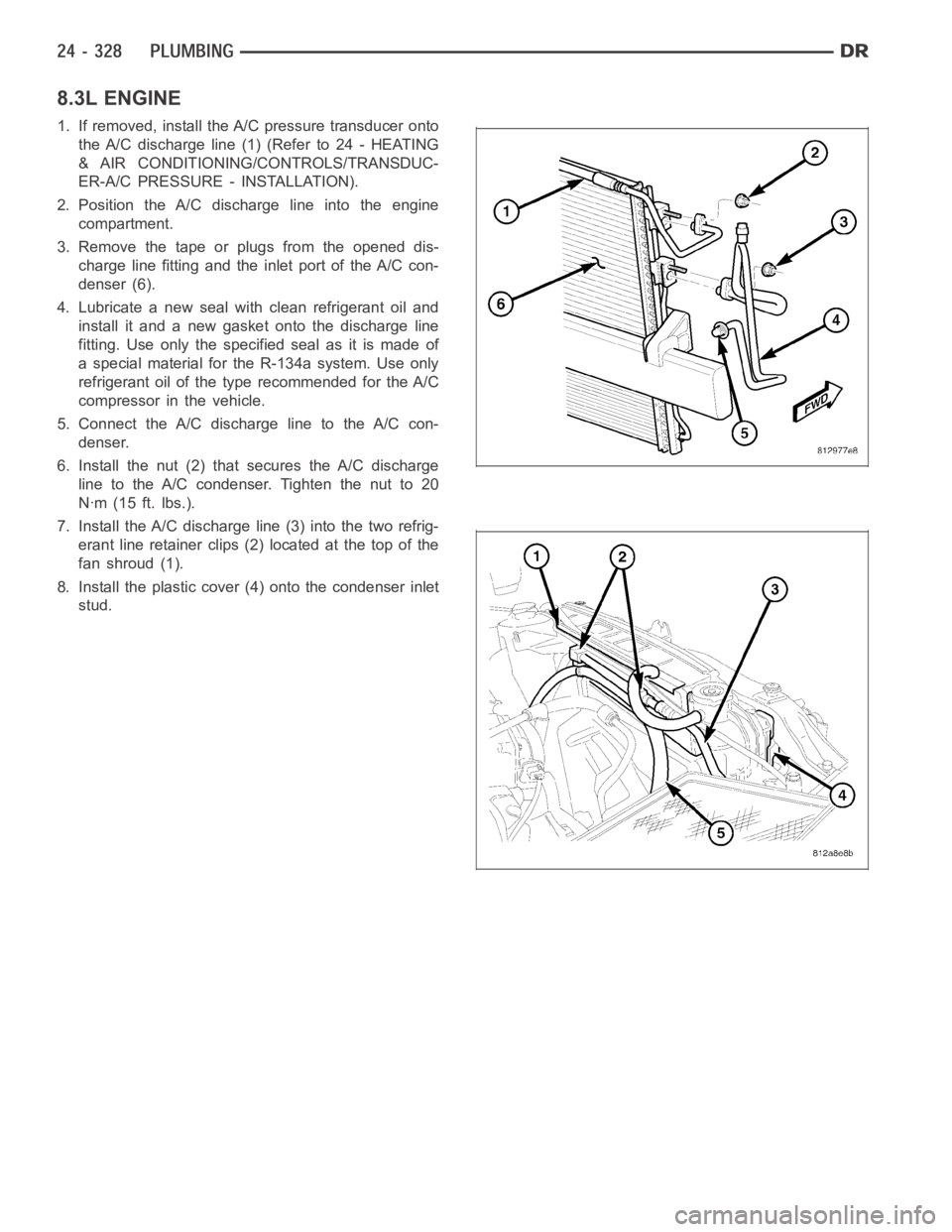
8.3L ENGINE
1. If removed, install the A/C pressure transducer onto
the A/C discharge line (1) (Refer to 24 - HEATING
& AIR CONDITIONING/CONTROLS/TRANSDUC-
ER-A/C PRESSURE - INSTALLATION).
2. Position the A/C discharge line into the engine
compartment.
3. Remove the tape or plugs from the opened dis-
charge line fitting and the inlet port of the A/C con-
denser (6).
4. Lubricate a new seal with clean refrigerant oil and
install it and a new gasket onto the discharge line
fitting. Use only the specified seal as it is made of
a special material for the R-134a system. Use only
refrigerant oil of the type recommended for the A/C
compressor in the vehicle.
5. Connect the A/C discharge line to the A/C con-
denser.
6. Install the nut (2) that secures the A/C discharge
line to the A/C condenser. Tighten the nut to 20
Nꞏm (15 ft. lbs.).
7. Install the A/C discharge line (3) into the two refrig-
erant line retainer clips (2) located at the top of the
fanshroud(1).
8. Install the plastic cover (4) onto the condenser inlet
stud.
Page 5171 of 5267
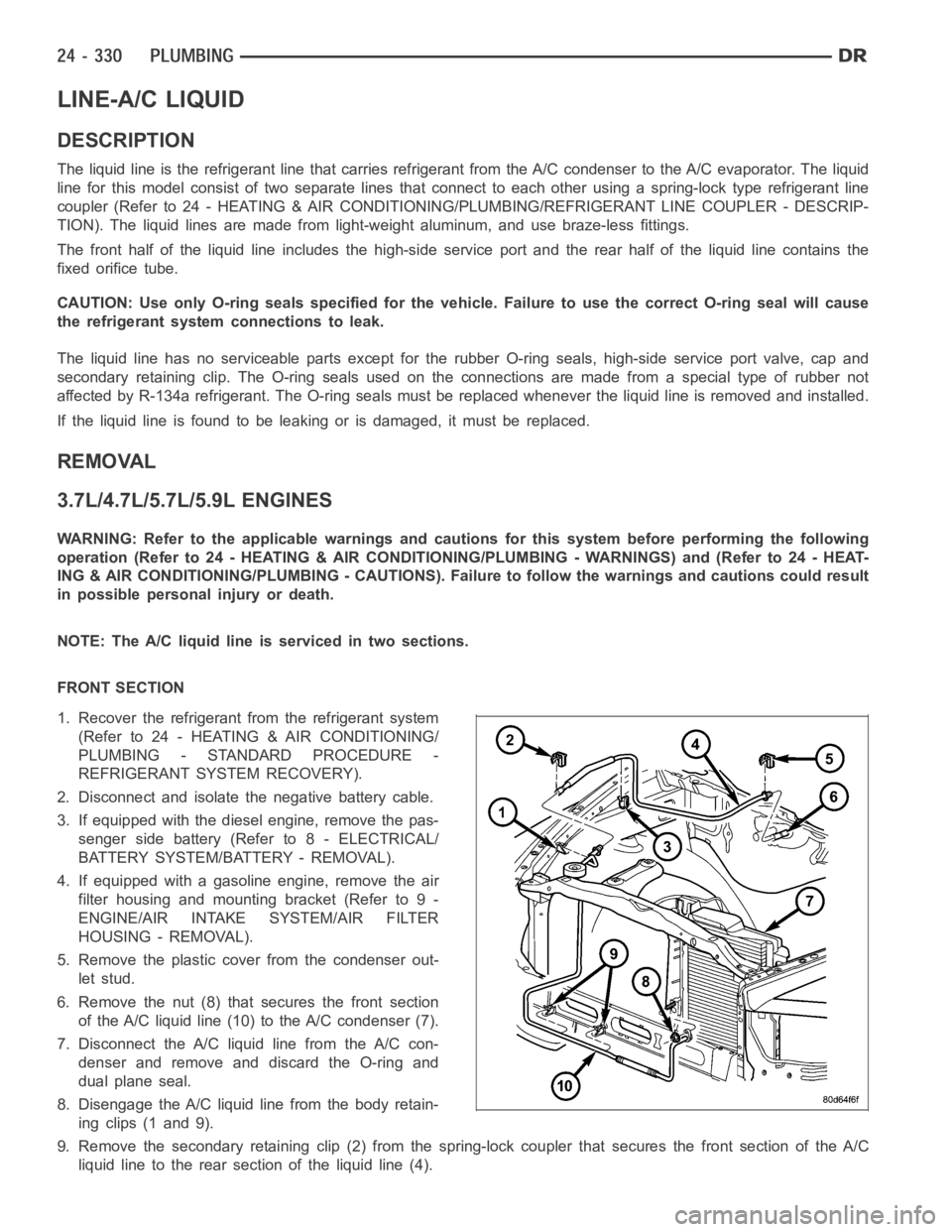
LINE-A/C LIQUID
DESCRIPTION
The liquid line is the refrigerant line that carries refrigerant from the A/C condenser to the A/C evaporator. The liquid
line for this model consist of two separate lines that connect to each otherusing a spring-lock type refrigerant line
coupler (Refer to 24 - HEATING & AIR CONDITIONING/PLUMBING/REFRIGERANT LINE COUPLER - DESCRIP-
TION). The liquid lines are made from light-weight aluminum, and use braze-less fittings.
The front half of the liquid line includes the high-side service port and the rear half of the liquid line contains the
fixed orifice tube.
CAUTION: Use only O-ring seals specified for the vehicle. Failure to use the correct O-ring seal will cause
the refrigerant system connections to leak.
The liquid line has no serviceable parts except for the rubber O-ring seals, high-side service port valve, cap and
secondary retaining clip. The O-ring seals used on the connections are made from a special type of rubber not
affected by R-134a refrigerant. The O-ring seals must be replaced whenever the liquid line is removed and installed.
If the liquid line is found to be leaking or is damaged, it must be replaced.
REMOVAL
3.7L/4.7L/5.7L/5.9L ENGINES
WARNING: Refer to the applicable warnings and cautions for this system before performing the following
operation (Refer to 24 - HEATING & AIR CONDITIONING/PLUMBING - WARNINGS) and (Refer to 24 - HEAT-
ING & AIR CONDITIONING/PLUMBING - CAUTIONS). Failure to follow the warnings and cautions could result
in possible personal injury or death.
NOTE:TheA/Cliquidlineisservicedintwosections.
FRONT SECTION
1. Recover the refrigerant from the refrigerant system
(Refer to 24 - HEATING & AIR CONDITIONING/
PLUMBING - STANDARD PROCEDURE -
REFRIGERANT SYSTEM RECOVERY).
2. Disconnect and isolate the negative battery cable.
3. If equipped with the diesel engine, remove the pas-
senger side battery (Refer to 8 - ELECTRICAL/
BATTERY SYSTEM/BATTERY - REMOVAL).
4. If equipped with a gasoline engine, remove the air
filter housing and mounting bracket (Refer to 9 -
ENGINE/AIR INTAKE SYSTEM/AIR FILTER
HOUSING - REMOVAL).
5. Remove the plastic cover from the condenser out-
let stud.
6. Remove the nut (8) that secures the front section
of the A/C liquid line (10) to the A/C condenser (7).
7. Disconnect the A/C liquid line from the A/C con-
denser and remove and discard the O-ring and
dual plane seal.
8. Disengage the A/C liquid line from the body retain-
ing clips (1 and 9).
9. Remove the secondary retaining clip (2) from the spring-lock coupler that secures the front section of the A/C
liquid line to the rear section of the liquid line (4).
Page 5172 of 5267
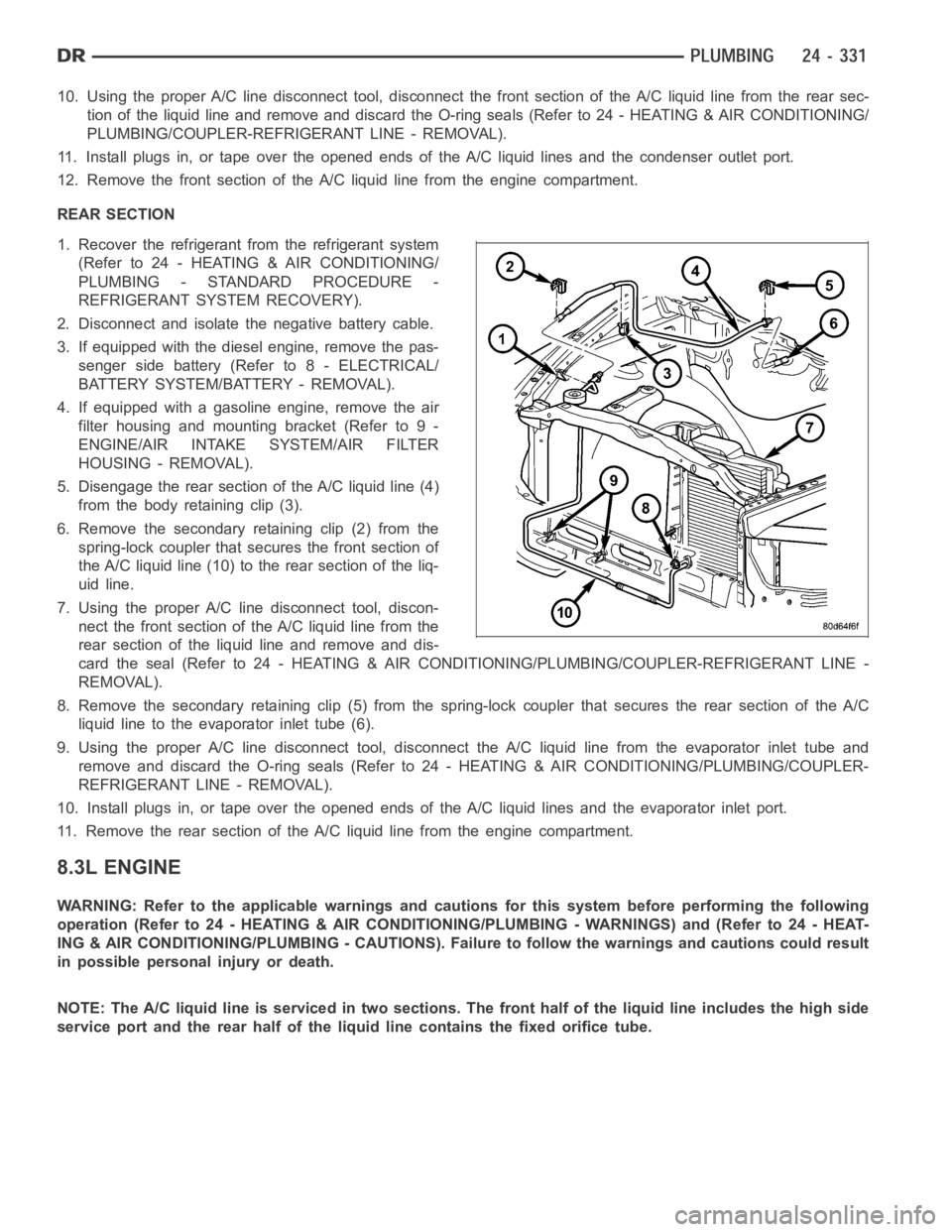
10. Using the proper A/C line disconnect tool, disconnect the front section of the A/C liquid line from the rear sec-
tion of the liquid line and remove and discard the O-ring seals (Refer to 24 -HEATING & AIR CONDITIONING/
PLUMBING/COUPLER-REFRIGERANT LINE - REMOVAL).
11. Install plugs in, or tape over the opened ends of the A/C liquid lines andthe condenser outlet port.
12. Remove the front section of the A/C liquid line from the engine compartment.
REAR SECTION
1. Recover the refrigerant from the refrigerant system
(Refer to 24 - HEATING & AIR CONDITIONING/
PLUMBING - STANDARD PROCEDURE -
REFRIGERANT SYSTEM RECOVERY).
2. Disconnect and isolate the negative battery cable.
3. If equipped with the diesel engine, remove the pas-
senger side battery (Refer to 8 - ELECTRICAL/
BATTERY SYSTEM/BATTERY - REMOVAL).
4. If equipped with a gasoline engine, remove the air
filter housing and mounting bracket (Refer to 9 -
ENGINE/AIR INTAKE SYSTEM/AIR FILTER
HOUSING - REMOVAL).
5. Disengage the rear section of the A/C liquid line (4)
from the body retaining clip (3).
6. Remove the secondary retaining clip (2) from the
spring-lock coupler that secures the front section of
the A/C liquid line (10) to the rear section of the liq-
uid line.
7. Using the proper A/C line disconnect tool, discon-
nect the front section of the A/C liquid line from the
rear section of the liquid line and remove and dis-
card the seal (Refer to 24 - HEATING & AIR CONDITIONING/PLUMBING/COUPLER-REFRIGERANT LINE -
REMOVAL).
8. Remove the secondary retaining clip (5) from the spring-lock coupler that secures the rear section of the A/C
liquid line to the evaporator inlet tube (6).
9. Using the proper A/C line disconnect tool, disconnect the A/C liquid line from the evaporator inlet tube and
removeanddiscardtheO-ringseals(Referto24-HEATING&AIRCONDITIONING/PLUMBING/COUPLER-
REFRIGERANT LINE - REMOVAL).
10. Install plugs in, or tape over the opened ends of the A/C liquid lines andthe evaporator inlet port.
11. Remove the rear section of the A/C liquid line from the engine compartment.
8.3L ENGINE
WARNING: Refer to the applicable warnings and cautions for this system before performing the following
operation (Refer to 24 - HEATING & AIR CONDITIONING/PLUMBING - WARNINGS) and (Refer to 24 - HEAT-
ING & AIR CONDITIONING/PLUMBING - CAUTIONS). Failure to follow the warnings and cautions could result
in possible personal injury or death.
NOTE: The A/C liquid line is serviced in two sections. The front half of the liquid line includes the high side
service port and the rear half of the liquid line contains the fixed orificetube.
Page 5173 of 5267
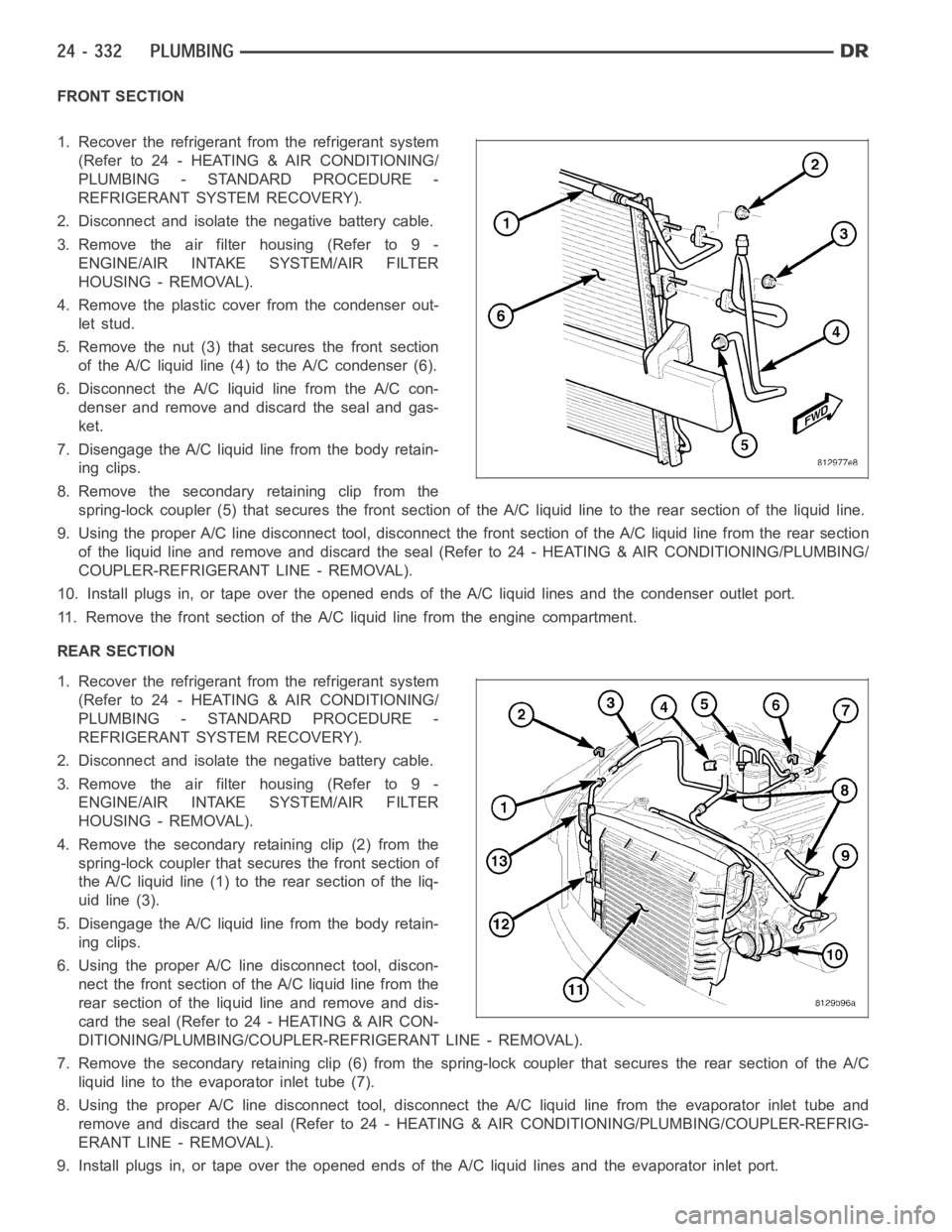
FRONT SECTION
1. Recover the refrigerant from the refrigerant system
(Refer to 24 - HEATING & AIR CONDITIONING/
PLUMBING - STANDARD PROCEDURE -
REFRIGERANT SYSTEM RECOVERY).
2. Disconnect and isolate the negative battery cable.
3.Removetheairfilterhousing(Referto9-
ENGINE/AIR INTAKE SYSTEM/AIR FILTER
HOUSING - REMOVAL).
4. Remove the plastic cover from the condenser out-
let stud.
5. Remove the nut (3) that secures the front section
of the A/C liquid line (4) to the A/C condenser (6).
6. Disconnect the A/C liquid line from the A/C con-
denser and remove and discard the seal and gas-
ket.
7. Disengage the A/C liquid line from the body retain-
ing clips.
8. Remove the secondary retaining clip from the
spring-lock coupler (5) that secures the front section of the A/C liquid line to the rear section of the liquid line.
9. Using the proper A/C line disconnect tool, disconnect the front sectionof the A/C liquid line from the rear section
of the liquid line and remove and discard the seal (Refer to 24 - HEATING & AIRCONDITIONING/PLUMBING/
COUPLER-REFRIGERANT LINE - REMOVAL).
10. Install plugs in, or tape over the opened ends of the A/C liquid lines andthe condenser outlet port.
11. Remove the front section of the A/C liquid line from the engine compartment.
REAR SECTION
1. Recover the refrigerant from the refrigerant system
(Refer to 24 - HEATING & AIR CONDITIONING/
PLUMBING - STANDARD PROCEDURE -
REFRIGERANT SYSTEM RECOVERY).
2. Disconnect and isolate the negative battery cable.
3.Removetheairfilterhousing(Referto9-
ENGINE/AIR INTAKE SYSTEM/AIR FILTER
HOUSING - REMOVAL).
4. Remove the secondary retaining clip (2) from the
spring-lock coupler that secures the front section of
the A/C liquid line (1) to the rear section of the liq-
uid line (3).
5. Disengage the A/C liquid line from the body retain-
ing clips.
6. Using the proper A/C line disconnect tool, discon-
nect the front section of the A/C liquid line from the
rear section of the liquid line and remove and dis-
cardtheseal(Referto24-HEATING&AIRCON-
DITIONING/PLUMBING/COUPLER-REFRIGERANT LINE - REMOVAL).
7. Remove the secondary retaining clip (6) from the spring-lock coupler that secures the rear section of the A/C
liquid line to the evaporator inlet tube (7).
8. Using the proper A/C line disconnect tool, disconnect the A/C liquid line from the evaporator inlet tube and
remove and discard the seal (Refer to 24 - HEATING & AIR CONDITIONING/PLUMBING/COUPLER-REFRIG-
ERANT LINE - REMOVAL).
9. Install plugs in, or tape over the opened ends of the A/C liquid lines and the evaporator inlet port.
Page 5174 of 5267
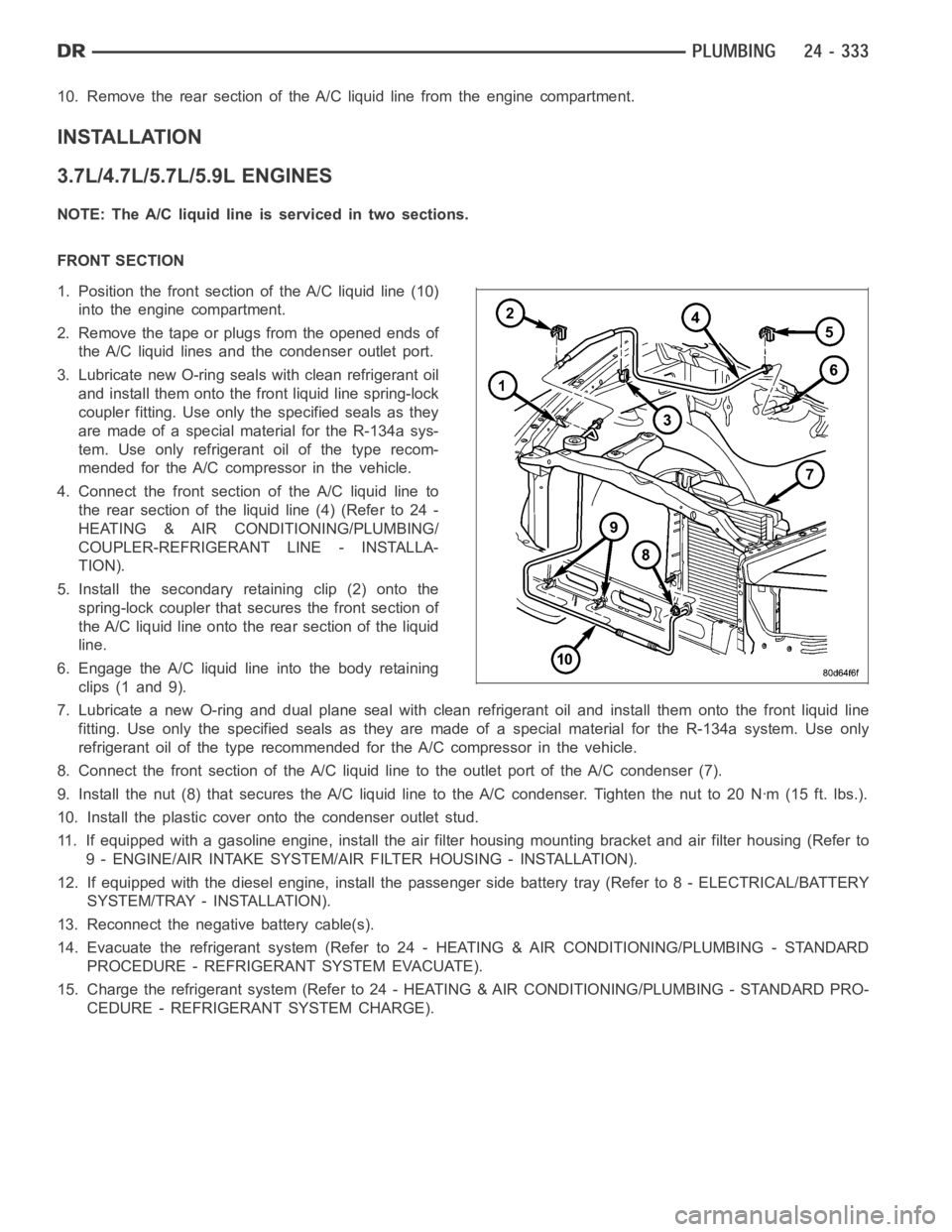
10. Remove the rear section of the A/C liquid line from the engine compartment.
INSTALLATION
3.7L/4.7L/5.7L/5.9L ENGINES
NOTE:TheA/Cliquidlineisservicedintwosections.
FRONT SECTION
1. Position the front section of the A/C liquid line (10)
into the engine compartment.
2. Remove the tape or plugs from the opened ends of
the A/C liquid lines and the condenser outlet port.
3. Lubricate new O-ring seals with clean refrigerant oil
and install them onto the front liquid line spring-lock
coupler fitting. Use only the specified seals as they
are made of a special material for the R-134a sys-
tem. Use only refrigerant oil of the type recom-
mended for the A/C compressor in the vehicle.
4. Connect the front section of the A/C liquid line to
the rear section of the liquid line (4) (Refer to 24 -
HEATING & AIR CONDITIONING/PLUMBING/
COUPLER-REFRIGERANT LINE - INSTALLA-
TION).
5. Install the secondary retaining clip (2) onto the
spring-lock coupler that secures the front section of
the A/C liquid line onto the rear section of the liquid
line.
6. Engage the A/C liquid line into the body retaining
clips (1 and 9).
7. Lubricate a new O-ring and dual plane seal with clean refrigerant oil andinstall them onto the front liquid line
fitting. Use only the specified seals as they are made of a special materialfor the R-134a system. Use only
refrigerant oil of the type recommended for the A/C compressor in the vehicle.
8. Connect the front section of the A/C liquid line to the outlet port of the A/C condenser (7).
9. Install the nut (8) that secures the A/C liquid line to the A/C condenser.Tighten the nut to 20 Nꞏm (15 ft. lbs.).
10. Install the plastic cover onto the condenser outlet stud.
11. If equipped with a gasoline engine, install the air filter housing mounting bracket and air filter housing (Refer to
9 - ENGINE/AIR INTAKE SYSTEM/AIR FILTER HOUSING - INSTALLATION).
12. If equipped with the diesel engine, install the passenger side batterytray (Refer to 8 - ELECTRICAL/BATTERY
SYSTEM/TRAY - INSTALLATION).
13. Reconnect the negative battery cable(s).
14. Evacuate the refrigerant system (Refer to 24 - HEATING & AIR CONDITIONING/PLUMBING - STANDARD
PROCEDURE - REFRIGERANT SYSTEM EVACUATE).
15. Charge the refrigerant system (Refer to 24 - HEATING & AIR CONDITIONING/PLUMBING - STANDARD PRO-
CEDURE - REFRIGERANT SYSTEM CHARGE).